2015 NISSAN VERSA SEDAN engine
[x] Cancel search: enginePage 351 of 374
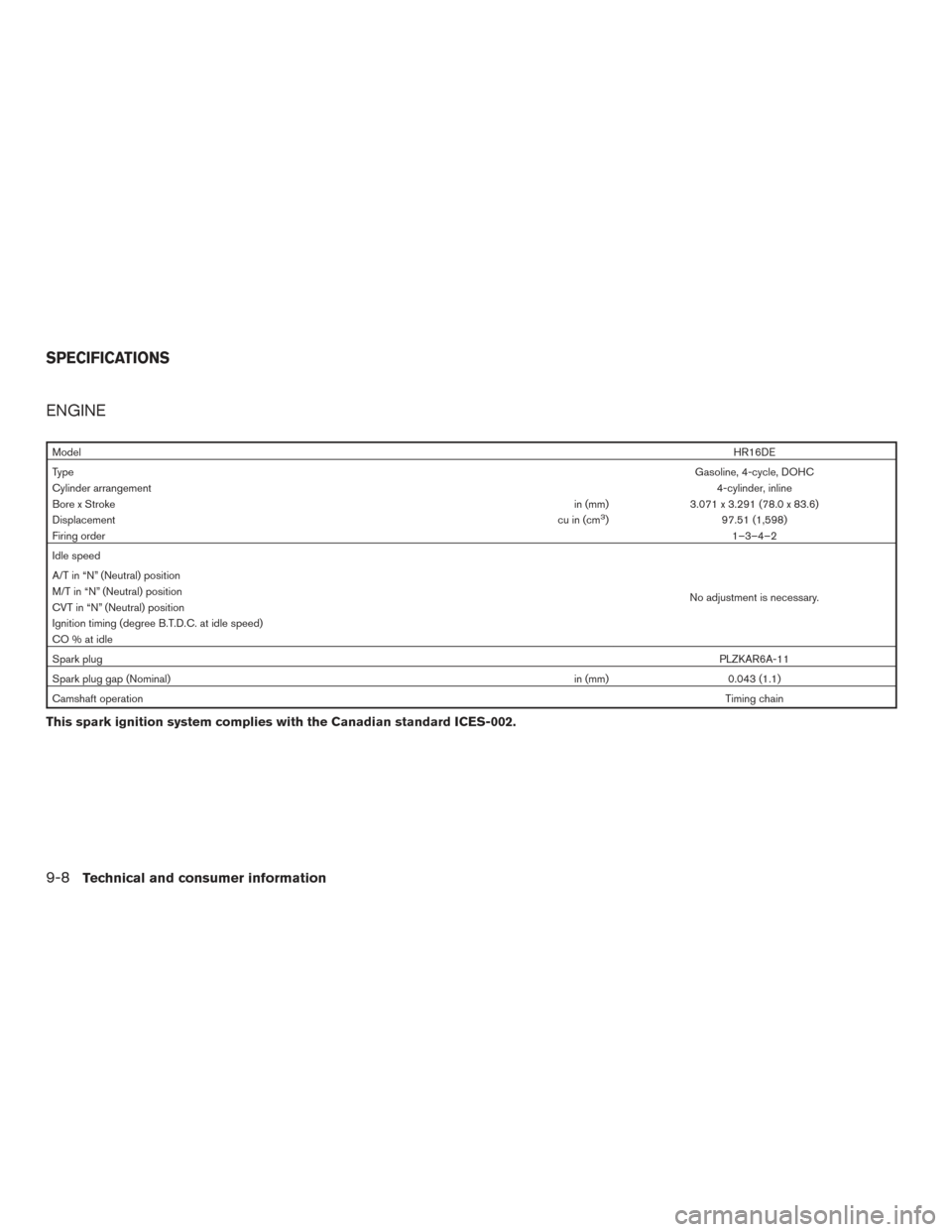
ENGINE
ModelHR16DE
Type Gasoline, 4-cycle, DOHC
Cylinder arrangement 4-cylinder, inline
Bore x Stroke in (mm)3.071 x 3.291 (78.0 x 83.6)
Displacement cu in (cm
3)97.51 (1,598)
Firing order 1–3–4–2
Idle speed
No adjustment is necessary.
A/T in “N” (Neutral) position
M/T in “N” (Neutral) position
CVT in “N” (Neutral) position
Ignition timing (degree B.T.D.C. at idle speed)
CO%atidle
Spark plug
PLZKAR6A-11
Spark plug gap (Nominal) in (mm)0.043 (1.1)
Camshaft operation Timing chain
This spark ignition system complies with the Canadian standard ICES-002.
SPECIFICATIONS
9-8Technical and consumer information
Page 353 of 374
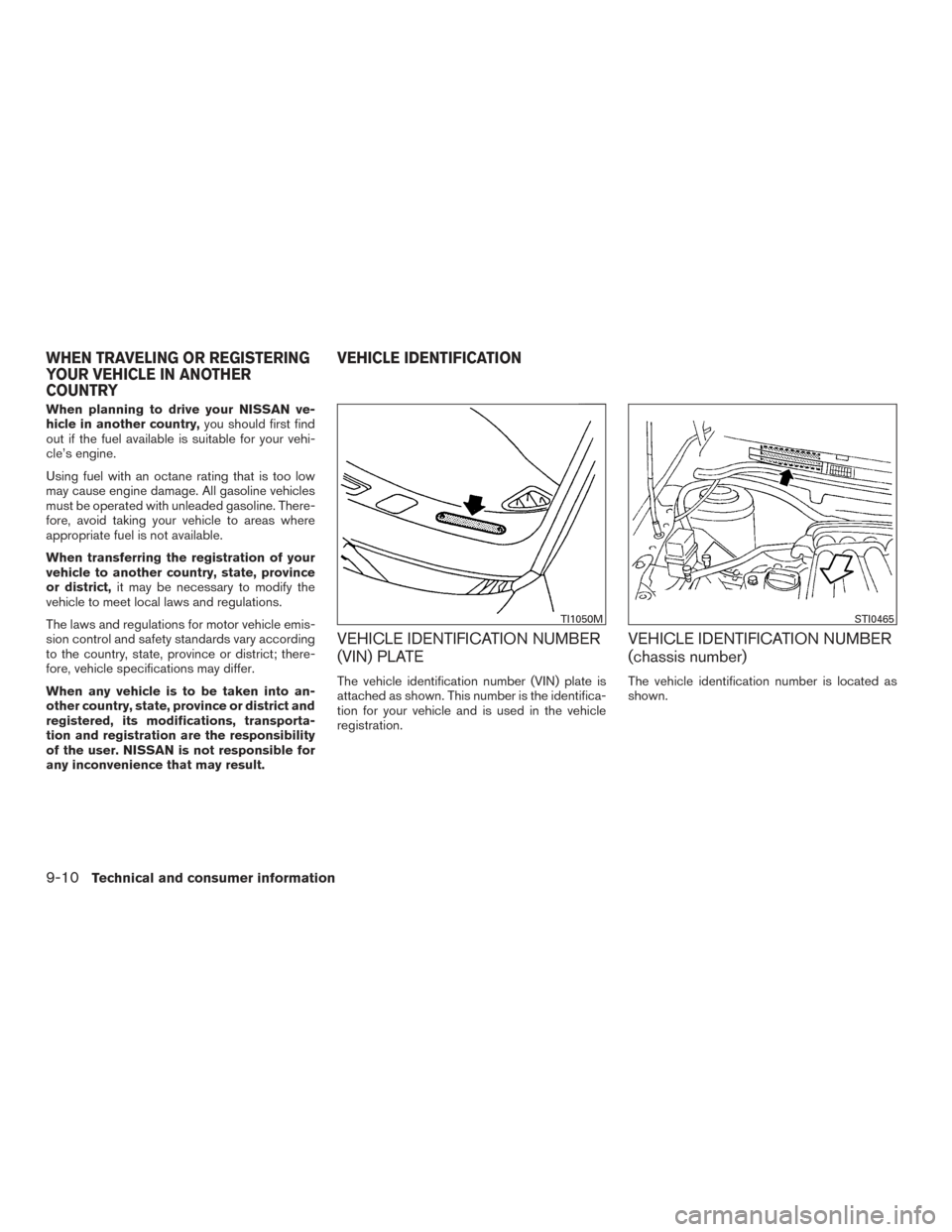
When planning to drive your NISSAN ve-
hicle in another country,you should first find
out if the fuel available is suitable for your vehi-
cle’s engine.
Using fuel with an octane rating that is too low
may cause engine damage. All gasoline vehicles
must be operated with unleaded gasoline. There-
fore, avoid taking your vehicle to areas where
appropriate fuel is not available.
When transferring the registration of your
vehicle to another country, state, province
or district, it may be necessary to modify the
vehicle to meet local laws and regulations.
The laws and regulations for motor vehicle emis-
sion control and safety standards vary according
to the country, state, province or district; there-
fore, vehicle specifications may differ.
When any vehicle is to be taken into an-
other country, state, province or district and
registered, its modifications, transporta-
tion and registration are the responsibility
of the user. NISSAN is not responsible for
any inconvenience that may result.
VEHICLE IDENTIFICATION NUMBER
(VIN) PLATE
The vehicle identification number (VIN) plate is
attached as shown. This number is the identifica-
tion for your vehicle and is used in the vehicle
registration.
VEHICLE IDENTIFICATION NUMBER
(chassis number)
The vehicle identification number is located as
shown.
TI1050MSTI0465
WHEN TRAVELING OR REGISTERING
YOUR VEHICLE IN ANOTHER
COUNTRY VEHICLE IDENTIFICATION
9-10Technical and consumer information
Page 354 of 374
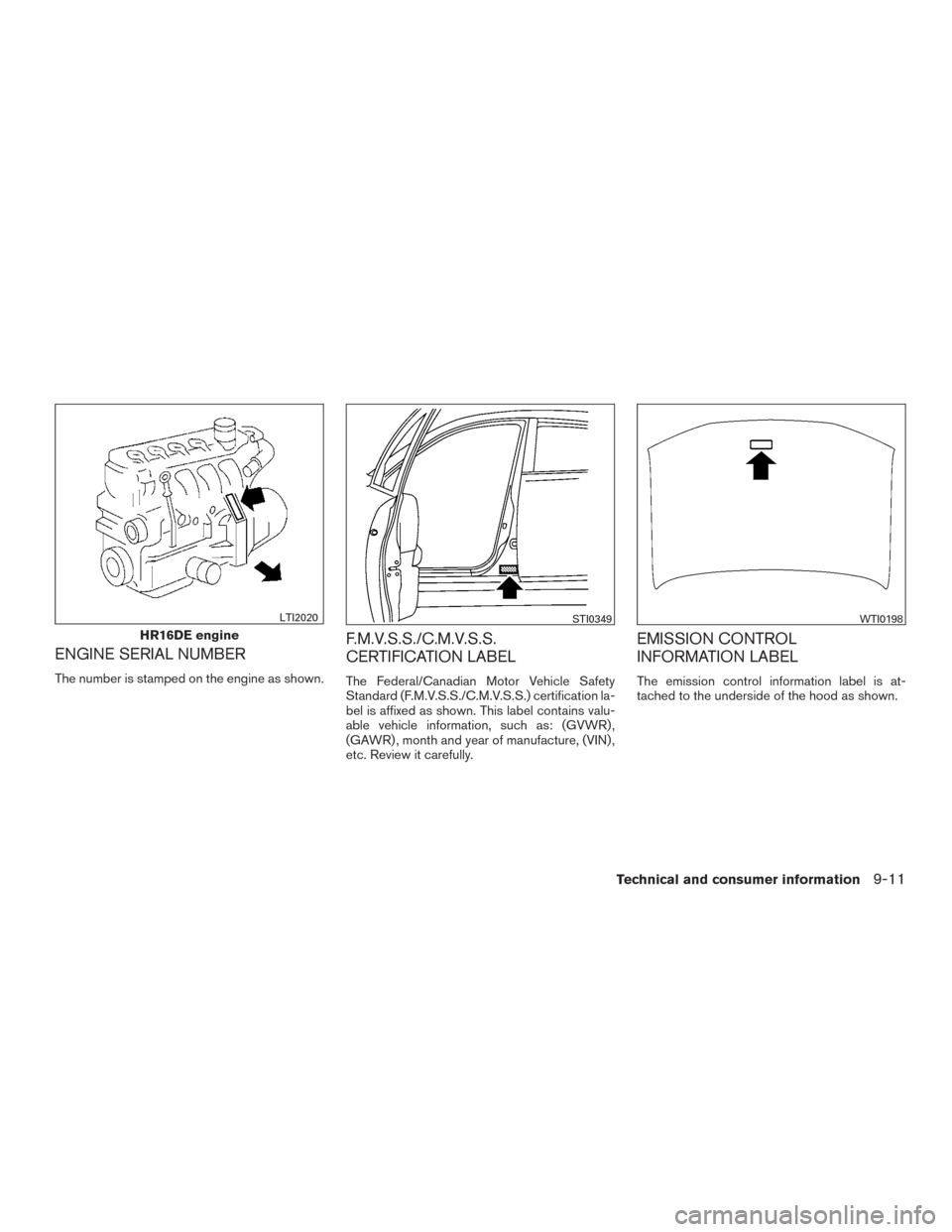
ENGINE SERIAL NUMBER
The number is stamped on the engine as shown.
F.M.V.S.S./C.M.V.S.S.
CERTIFICATION LABEL
The Federal/Canadian Motor Vehicle Safety
Standard (F.M.V.S.S./C.M.V.S.S.) certification la-
bel is affixed as shown. This label contains valu-
able vehicle information, such as: (GVWR) ,
(GAWR) , month and year of manufacture, (VIN) ,
etc. Review it carefully.
EMISSION CONTROL
INFORMATION LABEL
The emission control information label is at-
tached to the underside of the hood as shown.
HR16DE engine
LTI2020STI0349WTI0198
Technical and consumer information9-11
Page 360 of 374
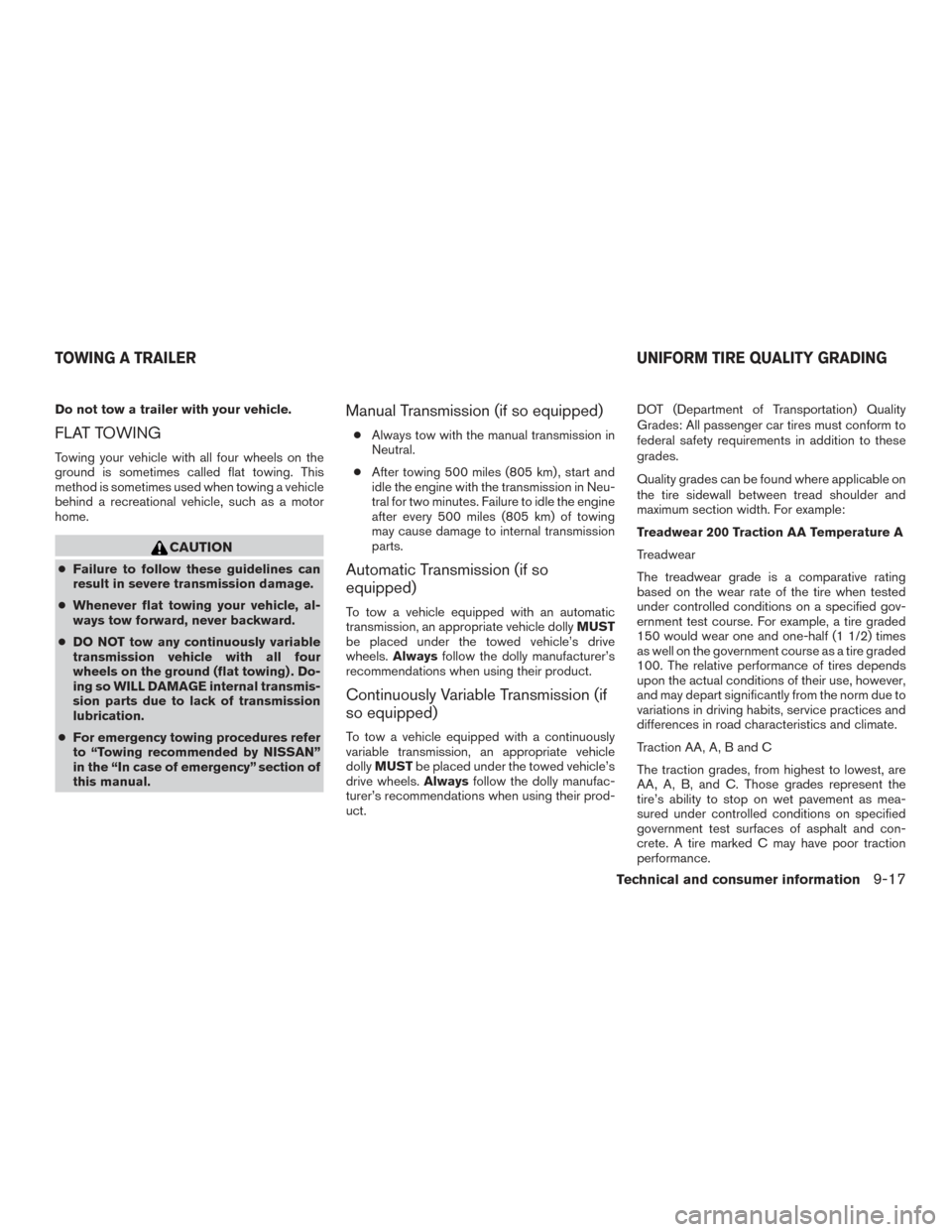
Do not tow a trailer with your vehicle.
FLAT TOWING
Towing your vehicle with all four wheels on the
ground is sometimes called flat towing. This
method is sometimes used when towing a vehicle
behind a recreational vehicle, such as a motor
home.
CAUTION
●Failure to follow these guidelines can
result in severe transmission damage.
● Whenever flat towing your vehicle, al-
ways tow forward, never backward.
● DO NOT tow any continuously variable
transmission vehicle with all four
wheels on the ground (flat towing) . Do-
ing so WILL DAMAGE internal transmis-
sion parts due to lack of transmission
lubrication.
● For emergency towing procedures refer
to “Towing recommended by NISSAN”
in the “In case of emergency” section of
this manual.
Manual Transmission (if so equipped)
● Always tow with the manual transmission in
Neutral.
● After towing 500 miles (805 km) , start and
idle the engine with the transmission in Neu-
tral for two minutes. Failure to idle the engine
after every 500 miles (805 km) of towing
may cause damage to internal transmission
parts.
Automatic Transmission (if so
equipped)
To tow a vehicle equipped with an automatic
transmission, an appropriate vehicle dolly MUST
be placed under the towed vehicle’s drive
wheels. Always follow the dolly manufacturer’s
recommendations when using their product.
Continuously Variable Transmission (if
so equipped)
To tow a vehicle equipped with a continuously
variable transmission, an appropriate vehicle
dolly MUST be placed under the towed vehicle’s
drive wheels. Alwaysfollow the dolly manufac-
turer’s recommendations when using their prod-
uct. DOT (Department of Transportation) Quality
Grades: All passenger car tires must conform to
federal safety requirements in addition to these
grades.
Quality grades can be found where applicable on
the tire sidewall between tread shoulder and
maximum section width. For example:
Treadwear 200 Traction AA Temperature A
Treadwear
The treadwear grade is a comparative rating
based on the wear rate of the tire when tested
under controlled conditions on a specified gov-
ernment test course. For example, a tire graded
150 would wear one and one-half (1 1/2) times
as well on the government course as a tire graded
100. The relative performance of tires depends
upon the actual conditions of their use, however,
and may depart significantly from the norm due to
variations in driving habits, service practices and
differences in road characteristics and climate.
Traction AA, A, B and C
The traction grades, from highest to lowest, are
AA, A, B, and C. Those grades represent the
tire’s ability to stop on wet pavement as mea-
sured under controlled conditions on specified
government test surfaces of asphalt and con-
crete. A tire marked C may have poor traction
performance.
TOWING A TRAILER
UNIFORM TIRE QUALITY GRADING
Technical and consumer information9-17
Page 363 of 374
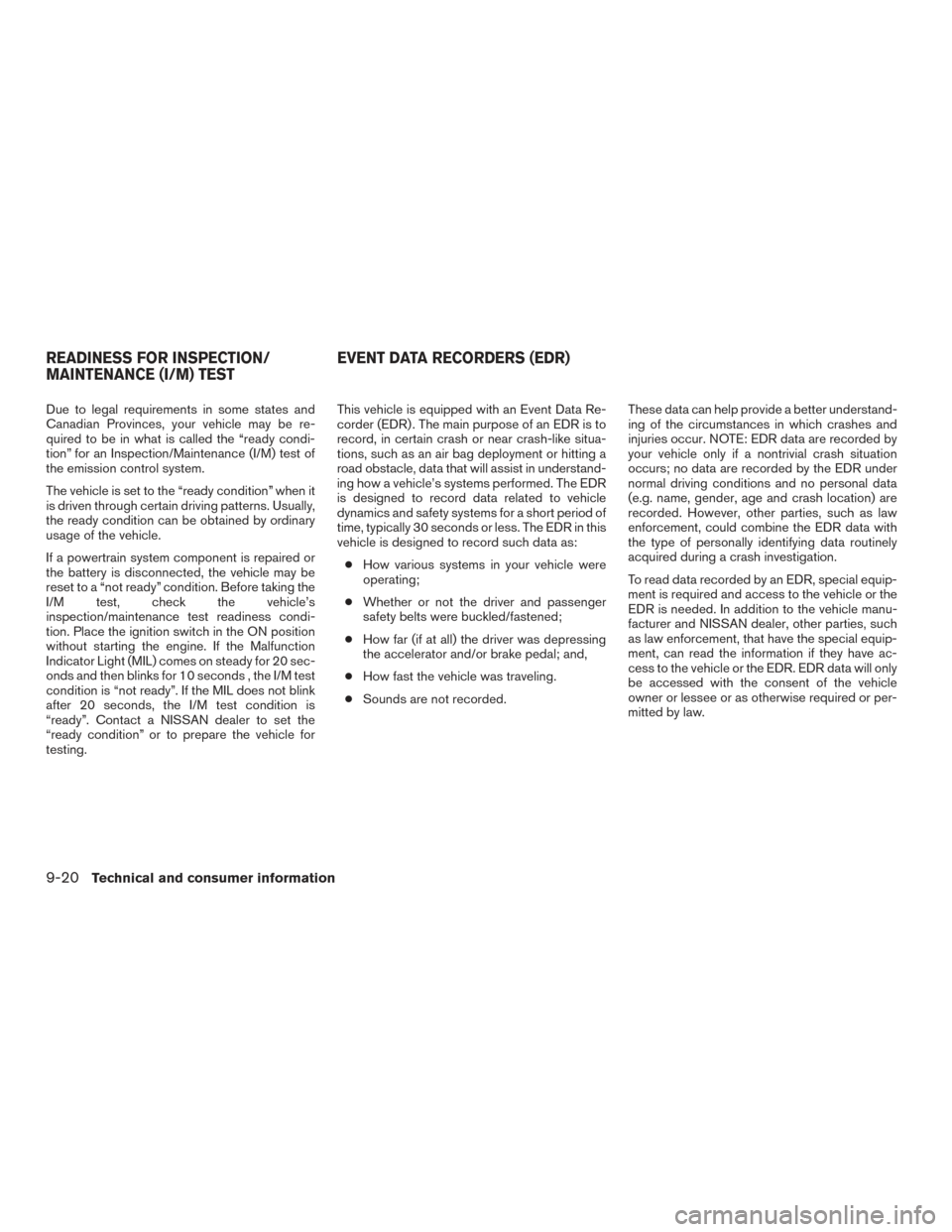
Due to legal requirements in some states and
Canadian Provinces, your vehicle may be re-
quired to be in what is called the “ready condi-
tion” for an Inspection/Maintenance (I/M) test of
the emission control system.
The vehicle is set to the “ready condition” when it
is driven through certain driving patterns. Usually,
the ready condition can be obtained by ordinary
usage of the vehicle.
If a powertrain system component is repaired or
the battery is disconnected, the vehicle may be
reset to a “not ready” condition. Before taking the
I/M test, check the vehicle’s
inspection/maintenance test readiness condi-
tion. Place the ignition switch in the ON position
without starting the engine. If the Malfunction
Indicator Light (MIL) comes on steady for 20 sec-
onds and then blinks for 10 seconds , the I/M test
condition is “not ready”. If the MIL does not blink
after 20 seconds, the I/M test condition is
“ready”. Contact a NISSAN dealer to set the
“ready condition” or to prepare the vehicle for
testing.This vehicle is equipped with an Event Data Re-
corder (EDR) . The main purpose of an EDR is to
record, in certain crash or near crash-like situa-
tions, such as an air bag deployment or hitting a
road obstacle, data that will assist in understand-
ing how a vehicle’s systems performed. The EDR
is designed to record data related to vehicle
dynamics and safety systems for a short period of
time, typically 30 seconds or less. The EDR in this
vehicle is designed to record such data as:
● How various systems in your vehicle were
operating;
● Whether or not the driver and passenger
safety belts were buckled/fastened;
● How far (if at all) the driver was depressing
the accelerator and/or brake pedal; and,
● How fast the vehicle was traveling.
● Sounds are not recorded. These data can help provide a better understand-
ing of the circumstances in which crashes and
injuries occur. NOTE: EDR data are recorded by
your vehicle only if a nontrivial crash situation
occurs; no data are recorded by the EDR under
normal driving conditions and no personal data
(e.g. name, gender, age and crash location) are
recorded. However, other parties, such as law
enforcement, could combine the EDR data with
the type of personally identifying data routinely
acquired during a crash investigation.
To read data recorded by an EDR, special equip-
ment is required and access to the vehicle or the
EDR is needed. In addition to the vehicle manu-
facturer and NISSAN dealer, other parties, such
as law enforcement, that have the special equip-
ment, can read the information if they have ac-
cess to the vehicle or the EDR. EDR data will only
be accessed with the consent of the vehicle
owner or lessee or as otherwise required or per-
mitted by law.
READINESS FOR INSPECTION/
MAINTENANCE (I/M) TEST
EVENT DATA RECORDERS (EDR)
9-20Technical and consumer information
Page 366 of 374
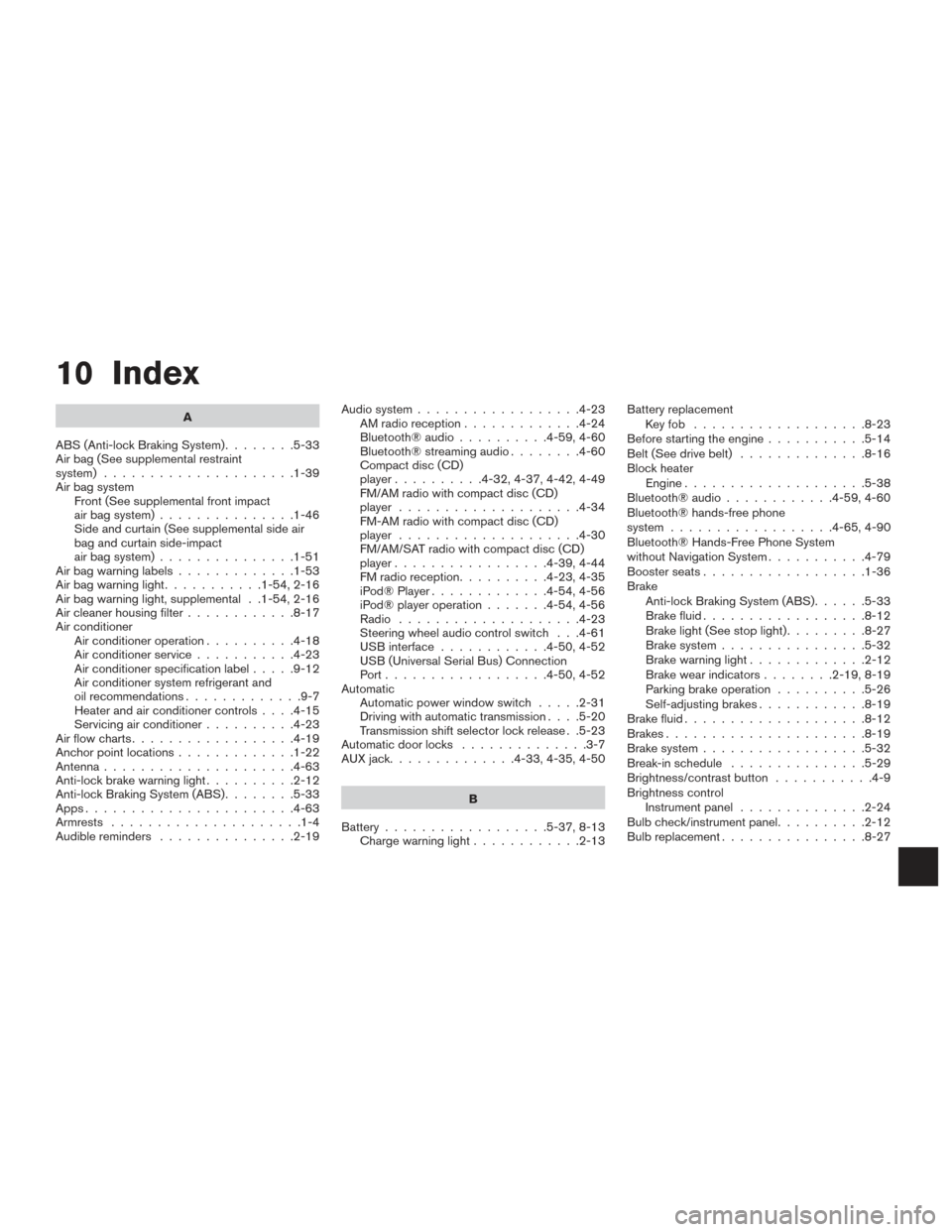
10 Index
A
ABS (Anti-lock Braking System) ........5-33
Air bag (See supplemental restraint
system) .....................1-39
Air bag system Front (See supplemental front impact
air bag system) ...............1-46
Side and curtain (See supplemental side air
bag and curtain side-impact
air bag system) ...............1-51
Airbagwarninglabels.............1-53
Airbagwarninglight...........1-54,2-16
Air bag warning light, supplemental . .1-54, 2-16
Air cleaner housing filter ............8-17
Air conditioner Air conditioner operation ..........4-18
Air conditioner service ...........4-23
Air conditioner specification label .....9-12
Air conditioner system refrigerant and
oil recommendations .............9-7
Heater and air conditioner controls ....4-15
Servicing air conditioner ..........4-23
Airflowcharts..................4-19
Anchor point locations .............1-22
Antenna .....................4-63
Anti-lock brake warning light ..........2-12
Anti-lock Braking System (ABS) ........5-33
Apps .......................4-63
Armrests .....................1-4
Audible reminders ...............2-19 Audio system
..................4-23
AMradioreception.............4-24
Bluetooth®audio..........4-59,4-60
Bluetooth® streaming audio ........4-60
Compact disc (CD)
player..........4-32,4-37,4-42,4-49
FM/AM radio with compact disc (CD)
player ....................4-34
FM-AM radio with compact disc (CD)
player ....................4-30
FM/AM/SAT radio with compact disc (CD)
player.................4-39,4-44
FMradioreception..........4-23,4-35
iPod® Player .............4-54,4-56
iPod® player operation .......4-54,4-56
Radio ....................4-23
Steering wheel audio control switch . . .4-61
USB interface ............4-50,4-52
USB (Universal Serial Bus) Connection
Port..................4-50,4-52
Automatic Automatic power window switch .....2-31
Driving with automatic transmission ....5-20
Transmission shift selector lock release . .5-23
Automatic door locks ..............3-7
AUXjack..............4-33,4-35,4-50
B
Battery ..................5-37,8-13
Chargewarninglight............2-13 Battery replacement
Keyfob ...................8-23
Before starting the engine ...........5-14
Belt (See drive belt) ..............8-16
Block heater Engine ....................5-38
Bluetooth® audio ............4-59,4-60
Bluetooth® hands-free phone
system..................4-65,4-90
Bluetooth® Hands-Free Phone System
without Navigation System ...........4-79
Boosterseats..................1-36
Brake Anti-lock Braking System (ABS) ......5-33
Brake fluid ..................8-12
Brakelight(Seestoplight).........8-27
Brake system ................5-32
Brakewarninglight.............2-12
Brakewearindicators........2-19,8-19
Parking brake operation ..........5-26
Self-adjusting brakes ............8-19
Brake fluid ....................8-12
Brakes ......................8-19
Brake system ..................5-32
Break-inschedule ...............5-29
Brightness/contrast button ...........4-9
Brightness control Instrument panel ..............2-24
Bulb check/instrument panel ..........2-12
Bulbreplacement................8-27
Page 367 of 374
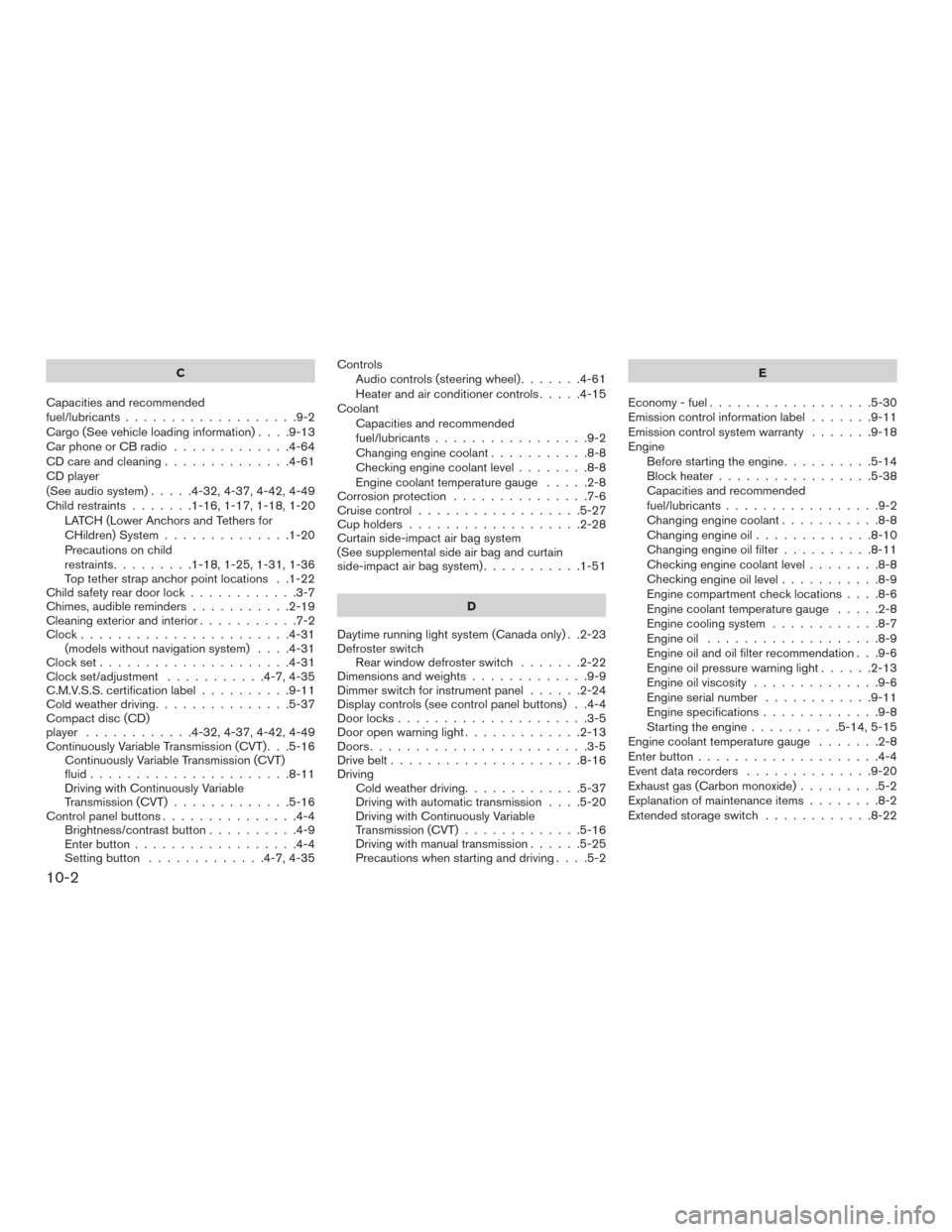
C
Capacities and recommended
fuel/lubricants ...................9-2
Cargo(Seevehicleloadinginformation)....9-13
Car phone or CB radio .............4-64
CD care and cleaning ..............4-61
CD player
(See audio system) .....4-32,4-37,4-42,4-49
Child restraints .......1-16,1-17,1-18,1-20
LATCH (Lower Anchors and Tethers for
CHildren) System ..............1-20
Precautions on child
restraints.........1-18,1-25,1-31,1-36
Top tether strap anchor point locations . .1-22
Child safety rear door lock ............3-7
Chimes, audible reminders ...........2-19
Cleaningexteriorandinterior...........7-2
Clock.......................4-31 (models without navigation system) ....4-31
Clockset.....................4-31
Clock set/adjustment ...........4-7,4-35
C.M.V.S.S. certification label ..........9-11
Cold weather driving ...............5-37
Compact disc (CD)
player ............4-32,4-37,4-42,4-49
Continuously Variable Transmission (CVT) . . .5-16 Continuously Variable Transmission (CVT)
fluid ......................8-11
Driving with Continuously Variable
Transmission (CVT) .............5-16
Control panel buttons ...............4-4
Brightness/contrast button ..........4-9
Enterbutton..................4-4
Setting button .............4-7,4-35 Controls
Audio controls (steering wheel) .......4-61
Heater and air conditioner controls .....4-15
Coolant Capacities and recommended
fuel/lubricants .................9-2
Changingenginecoolant...........8-8
Checking engine coolant level ........8-8
Engine coolant temperature gauge .....2-8
Corrosion protection ...............7-6
Cruisecontrol..................5-27
Cupholders...................2-28
Curtain side-impact air bag system
(See supplemental side air bag and curtain
side-impact air bag system) ...........1-51
D
Daytime running light system (Canada only) . .2-23
Defroster switch Rear window defroster switch .......2-22
Dimensionsandweights.............9-9
Dimmer switch for instrument panel ......2-24
Display controls (see control panel buttons) . .4-4
Door locks .....................3-5
Door open warning light .............2-13
Doors ........................3-5
Drive belt .....................8-16
Driving Cold weather driving .............5-37
Driving with automatic transmission ....5-20
Driving with Continuously Variable
Transmission (CVT) .............5-16
Driving with manual transmission ......5-25
Precautions when starting and driving ....5-2 E
Economy-fuel..................5-30
Emission control information label .......9-11
Emission control system warranty .......9-18
Engine Before starting the engine ..........5-14
Blockheater.................5-38
Capacities and recommended
fuel/lubricants.................9-2
Changing engine coolant ...........8-8
Changingengineoil.............8-10
Changing engine oil filter ..........8-11
Checking engine coolant level ........8-8
Checking
engine oil level ...........8-9
Engine compartment check locations ....8-6
Engine coolant temperature gauge .....2-8
Engine cooling system ............8-7
Engineoil ...................8-9
Engine oil and oil filter recommendation . . .9-6
Engine oil pressure warning light ......2-13
Engine oil viscosity ..............9-6
Engine serial number ............9-11
Engine specifications .............9-8
Starting the engine ..........5-14,5-15
Engine coolant temperature gauge .......2-8
Enter button ....................4-4
Event data recorders ..............9-20
Exhaust gas (Carbon monoxide) .........5-2
Explanation of maintenance items ........8-2
Extended storage switch ............8-22
10-2
Page 368 of 374

F
Flashers (See hazard warning flasher switch) . .6-2
Flat tire .......................6-3
Floor mat positioning aid .............7-6
Fluid Brake fluid ..................8-12
Capacities and recommended
fuel/lubricants .................9-2
Continuously Variable Transmission (CVT)
fluid......................8-11
Engine coolant .................8-7
Engine oil ...................8-9
F.M.V.S.S. certification label ...........9-11
Foglightswitch .................2-25
Front air bag system
(See supplemental restraint system) ......1-46
Frontseats.....................1-2
Fuel Capacities and recommended
fuel/lubricants .................9-2
Fuel economy ................5-30
Fuel-filler door and cap ...........3-27
Fuel-filler door lock opener lever ......3-27
Fuel gauge ...................2-9
Fuel octane rating ...............9-5
Fuel recommendation .............9-4
Loose fuel cap warning ........2-6,3-27
Fuel gauge .....................2-9
Fuses.......................8-20
Fusible links ...................8-20 G
Gascap .....................3-27
Gauge Engine coolant temperature gauge .....2-8
Fuel gauge ...................2-9
Odometer ...................2-5
Speedometer .................2-5
Tachometer ..................2-7
Trip computer .................2-9
Trip odometer .................2-5
General maintenance ...............8-2
Glovebox.....................2-29
H
Hands-free phone system,
Bluetooth®................4-65,4-90
Hazard warning flasher switch ..........6-2
Headlight and turn signal switch ........2-22
Headlight control switch ............2-22
Headlights ....................8-25
Head restraints ..................1-5
Heater Heater and air conditioner controls .....4-15
Heater operation ...............4-17
Hood release ...................3-24
Horn .......................2-25
I
Ignition switch ...................5-8
Ignition Switch Push-Button Ignition Switch ........5-11Immobilizer system
......2-19,3-4,5-10,5-14
Important vehicle information label .......9-11
Increasing fuel economy .............5-30
Indicator lights and audible reminders
(See warning/indicator lights and audible
reminders)....................2-11
Inside mirror ...................3-31
Instrument brightness control ..........2-24
Instrumentpanel...............0-6,2-2
Instrument panel dimmer switch ........2-24
Intelligent Key system Key operating range .............3-13
Key operation ................
3-15
Mechanical key ................3-4
Remote keyless entry operation.......3-18
Troubleshooting guide ............3-23
Warning signals ...............3-23
Interior light ................2-31,2-32
Interior trunk lid release .............3-26
iPod®Player ............... 4-54, 4-56
ISOFIX child restraints .............1-20
J
Jump starting ................6-8,8-15
K
Key.........................3-2
Key fob battery replacement ..........8-23
Keyless entry With Intelligent Key system
(See Intelligent Key system) .........3-18
10-3